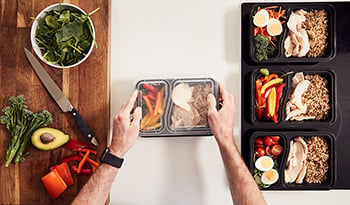Kan Şekeri Dengesi Nasıl Elde Edilir: En İyi Yiyecekler ve Yaşama Tarzı İpuçları

Kan Şekeri Nedir?
Kan şekeri olarak da bilinen kan şekeri, kanda bulunan ana şekerdir. Yiyecekleri tükettiğinizde ve sindirdiğinizde, vücudunuz yiyecekleri kan dolaşımına salınan glikoza ayırır. Pankreas tarafından üretilen önemli bir hormon olan insülin, glikozun hücrelere taşınmasına yardımcı olmak için çok önemlidir. Diyabet, kan şekeri seviyeleri çok yüksek olduğunda ortaya çıkar. Zamanla, yüksek kan şekeri seviyeleri tip 2 diyabet, kalp hastalığı, sinir hasarı, göz problemleri ve böbrek hastalığı gibi çeşitli sağlık sorunlarına katkıda bulunabilir.
Amerika Birleşik Devletleri'nde yaşayan her yaştan yaklaşık 37,3 milyon insan (nüfusun %11.3'ü) 2019'da diyabet hastasıydı.1
Yüksek Kan Şekeri Seviyelerine Neden Olan Nedir?
Yüksek kan şekeri seviyeleri aşağıdakiler de dahil olmak üzere bir dizi faktör tarafından tetiklenebilir:
- Stres
- Hastalık
- Aşırı yeme
- Öğün aralarında atıştırma
- İşlenmiş gıdalar veya şeker bakımından yüksek diyet
- Egzersiz eksikliği
- Yetersiz uyku kalitesi veya miktarı
- Dehidrasyon
- Bazı ilaçlar
Tip 1 Diyabet Nedir?
Tip 1 diyabet tipik olarak çocukluk döneminde gelişen otoimmün bir durumdur. Tip 1 diyabet ile vücut pankreas hücrelerine saldırır ve yok eder. Pankreas, glikozun kandan vücut hücrelerine taşınmasına yardımcı olan hormon olan insülin üretir. Sonunda pankreas insülin üretemez, bu nedenle glikoz kan dolaşımında kalır ve kan şekeri seviyeleri yükselir. Tip 1 diyabetli kişiler, kan şekerini hücrelere taşımaya ve kan şekerini normal seviyelerde tutmaya yardımcı olmak için günlük insülin aşılarına veya bir insülin pompasına ihtiyaç duyarlar.
Tip 2 Diyabet Nedir?
Tip 2 diyabet bazen yetişkinlikte teşhis edildiği için “yetişkin başlangıçlı” diyabet olarak adlandırılır. Obezite, egzersiz eksikliği, kronik stres ve sağlıksız beslenme alışkanlıkları, tip 2 diyabet geliştirme riskini artırabilir.
Gestasyonel Diyabet Nedir?
Gebelik diyabeti, hamilelik sırasında ortaya çıkan bir diyabet türüdür. Hamilelik sırasında, vücut doğal olarak kilo alır ve daha fazla hormon üretir, bu da genel olarak hormonal sağlıkta değişikliklere neden olabilir. Vücudun hücreleri insülini daha az verimli kullanabilir, bu da insülin direncine ve gebelik diyabeti riskinin artmasına neden olabilir. İnsülin ve kan şekeri seviyeleri hamilelikten sonra normale dönebilirken, gestasyonel diyabetli kadınların% 50'si tip 2 diyabet geliştirir.
Gebelik diyabeti olması düşük yapma, erken doğum, 9 kilodan fazla doğum ağırlığı ve düşük kan şekeri seviyesine sahip bir bebek riskini artırabilir. Gebelik diyabeti teşhisi konursa, hamilelik ve doğum sonrası boyunca sağlıklı kan şekeri seviyelerini yönetme ve sürdürme konusunda size rehberlik edebilecek kayıtlı bir diyetisyen, beslenme uzmanı ve sertifikalı diyabet eğitimcisi ile çalışmak önemlidir.
Diyabet Risk Faktörleri
Sağlıklı yaşam tarzı seçimleriyle tip 2 diyabet gelişimini önleyebilir veya geciktirebilirseniz de, tip 1 ve tip 2 diyabet geliştirme olasılığınızı etkileyen diğer risk faktörlerini kontrol edemezsiniz. Aile öyküsü, genetik ve etnik köken, hem tip 1 hem de tip 2 diyabet geliştirme riskinizi etkiler.
Kan Şekeri Seviyeleri Neden Önemlidir?
Kan şekeri seviyelerini sağlıklı bir aralıkta tutmak diyabet ve kalp hastalığı riskinizi azaltabilir. Kronik yüksek kan şekeri seviyeleri gözlere, sinirlere, böbreklere ve kan damarlarına zarar verme riskini artırabilir.
Optimal Kan Şekeri Seviyeleri Nelerdir?
Optimal açlık veya postprandial (yemek sonrası) kan şekeri seviyeleri aşağıdaki aralıklara girmelidir:
Diyabet Olmayan Kişiler
- Açlık kan şekeri: Desilitre başına 100 miligramdan az (mg/dl)
- Yemeklerden bir saat sonra: 140 mg/dl'den az
- Yemeklerden iki saat sonra: 120 mg/dl'den az
Gebelik
- Açlık kan şekeri: 95 mg/dl'den az
- Yemeklerden bir saat sonra: 140 mg/dl'den az
Tip 1 Diyabetli Yetişkinler
- Açlık kan şekeri: 80 ila 130 mg/dl
- Yemeklerden bir ila 2 saat sonra: 180 mg/dl'den az
Tip 2 Diyabetli Yetişkinler
- Açlık kan şekeri: 80 ila 130 mg/dl
- Yemeklerden bir ila 2 saat sonra: 180 mg/dl'den az
A1C nedir?
Hemoglobin A1C veya HbA1c, son üç aydaki ortalama kan şekeri seviyelerini ölçen bir kan testidir. A1C testi genellikle hem prediyabet hem de diyabeti teşhis etmek için kullanılır ve zaman içinde diyabetin izlenmesine ve yönetilmesine yardımcı olmak için kullanılır.2 Yüksek A1C, diyabet komplikasyonları riskinin artmasıyla bağlantılıdır, bu nedenle zaman içinde sağlıklı kan şekeri seviyelerini koruyarak A1C seviyelerini kontrol etmek önemlidir.
Hiperglisemi Nedir?
Yüksek kan şekeri veya yüksek kan şekeri olarak da bilinen hiperglisemi, kandaki şeker seviyesi yükseldiğinde ortaya çıkar. Hiperglisemi belirtileri şunlardır:
- Susuzluk
- Yorgunluk
- Zayıf hissetmek
- Baş ağrısı
- Sık idrara çıkma
- Bulanık görme
Hipoglisemi Nedir?
Düşük kan şekeri veya düşük kan şekeri olarak da bilinen hipoglisemi, kandaki şeker seviyesi çok düşük olduğunda ortaya çıkar. Hipoglisemi belirtileri şunlardır:
- Terleme
- Açlık
- Zayıf hissetmek
- Karar verme zorluğu
- Sinirlilik
- Karışıklık
- Baş dönmesi
Kan Şekerinizi Doğal Olarak Nasıl Düşürürsünüz
Birçok diyet ve yaşam tarzı alışkanlığı doğal olarak kan şekeri seviyelerini düşürmeye yardımcı olabilir! Kan şekeri seviyelerini düşürmek veya korumak için bu sağlıklı alışkanlıkları dahil edin.
- Hareket. Sağlıklı kan şekeri seviyelerini desteklemek için günlük 30 dakikalık sürekli hareket etmeyi hedefleyin. Bir yemekten veya atıştırmalıktan sonra yürüyüş yapmak, vücudun kan şekeri seviyelerini düşürmeye yardımcı olmak için glikoz kullanmasına da yardımcı olabilir.
- Önce protein yiyin: Bazı araştırmalar, önce öğününüzde veya atıştırmalıklarınızda protein ve lif bakımından zengin yiyecekleri yemenin, ardından karbonhidratlı yiyecekleri yemenin kan şekerinin düşmesine neden olabileceğini düşündürmektedir.3 Tüm öğünlere ve atıştırmalıklara bir protein kaynağı eklemeyi hedefleyin.
- Yüksek lifli bir diyet yiyin: Lif bakımından zengin gıdalar sadece bağırsak düzenliliğini ve bağırsak sağlığını desteklemekle kalmaz, aynı zamanda kan şekeri artışlarını azaltmaya da yardımcı olur. Yeterli lif tükettiğinizden emin olmak için bütün, bitki bazlı yiyecekleri vurgulayın.
- Hidratlı kalın: Dehidrasyon kan şekeri seviyelerini olumsuz yönde etkileyebilir. Filtrelenmiş su, bitki çayları ve salatalık, marul ve turunçgiller gibi su yoğun yiyeceklerle nemli kalın.
- Bütün yiyecekleri yiyin: Meyveler, sebzeler, kuruyemişler, tohumlar, baklagiller ve kepekli tahıllar gibi bütün yiyecekler, sindirimi yavaşlatan ve kan şekeri seviyelerinin yükselmesini azaltan lif içerir.
- İşlenmiş gıdalardan kaçının: Kan şekeri seviyelerini yükseltebilecek rafine unlar ve ilave şekerler içeren işlenmiş gıdaları sınırlayın veya bunlardan kaçının.
- Stresi azaltın: Meditasyon, okuma, sakinleştirici müzik dinleme, yürüyüşe çıkmak, doğada vakit geçirmek, bir arkadaşınızla konuşmak, banyo yapmak, meditasyon yapmak, günlük tutmak veya uyumak gibi stres seviyenizi düşürmeye yardımcı olabilecek günlük alışkanlıklar uygulayın! Kronik olarak stresli olduğunuzda, vücudunuz, yaşadığınız algılanan tehditten kaçmanıza yardımcı olmak için kortizol ve adrenalin üretir. İnsülin seviyeleri ayrıca vücudunuzun tehlikeden kaçması gerektiğini düşündüğü ilave yakıt için kana şeker salmak için artabilir. Bununla birlikte, günümüzde çoğu stresli durum tehlikeden kaçmayı gerektirmez. Bunun yerine, bilgisayarlarımızın başında otururken, işe gidip gelirken veya telefonlarımıza bakarken stresli olabiliriz. Sağlıklı, stres azaltıcı alışkanlıkları birleştirerek, insülin ve kan şekeri seviyenizi daha iyi destekleyebilirsiniz.
- Uyku: Yeterli uyku genel sağlık ve sağlıklı kan şekeri seviyeleri için gereklidir. Bol araştırma, düşük kaliteli uyku, yetersiz veya aşırı uyku ve düzensiz uykunun hepsinin glikoz intoleransını desteklediğini göstermektedir.4
Daha İyi Kan Şekeri Dengesi İçin 10 Yiyecek
- Elma sirkesi: Yemekten önce suda seyreltilmiş 4 çay kaşığı elma sirkesitüketmenin yemek sonrası (yemek sonrası) kan şekeri seviyelerini düşürdüğü gösterilmiştir.5 Bu, hem kan şekeri seviyelerini hem de insülin sağlığını desteklemeye yardımcı olabilir.
- Badem: Badem , tokluk ve glisemik kontrolü teşvik etmeye yardımcı olan lif, çinko, magnezyumve tekli doymamış yağlar içerir.
- Bitter çikolata: Bitter çikolata magnezyum içerir. Magnezyum kas gevşemesinde önemli bir rol oynar ve daha iyi uykuyu destekleyebilir ve stres duygularını azaltmaya yardımcı olabilir, bunların tümü daha iyi kan şekeri yönetimi için önemlidir.6 A magnezyum takviyesi ayrıca magnezyum ihtiyaçlarınızı karşılamanıza yardımcı olabilir.
- Tarçın: Araştırmalar, bir öğüne veya atıştırmalığa tarçın eklemenin kan şekeri seviyelerini düşürmeye yardımcı olabileceğini gösteriyor.7
- Kenevir tohumu: Bir 2 yemek kaşığı kenevir tohumu porsiyonu lif ve omega-3 yağlarıile birlikte 10 gram bitki bazlı protein sağlar. Kenevir kalpleri olarak da adlandırılan kenevir tohumları, kan şekeri seviyelerini desteklemek için mükemmel tohumlardır.
- Kuru erik: Kuru erik atıştırmalık olarak veya bir yemeği, atıştırmalıkları veya pişmiş tarifleri tatlandırmanın doğal bir yolu olarak tek başına harikadır. Kuru erik düşük glisemik bir meyvedir ve kan şekeri seviyelerini hafifletmeye yardımcı olabilecek çözünür lif içerir.
- Fındık ezmesi: Kuruyemişler yağ, protein ve lif bakımından zengindir, bunların hepsinin sindirimi karbonhidratlardan daha uzun sürer ve sağlıklı kan şekeri seviyelerini desteklemeye yardımcı olur.
- Mercimek: Mercimek yüksek proteinli, yüksek lifli bir baklagildir. Bol araştırmalar baklagiller tüketmenin diyabet riskini azaltmaya yardımcı olabileceğini düşündürmektedir.8
- Yulaf: Yulaf vücuttaki mikrobiyal çeşitliliği ve bağırsak düzenliliğini destekleyen çözünür ve çözünmeyen lif içerir. Yulafın A1C seviyelerini önemli ölçüde azaltmaya yardımcı olduğu bile gösterilmiştir.9
- Kabak Çekirdeği: Kabak çekirdeği kan şekeri kontrolü için harikadır. Protein, lif, sağlıklı yağlar ve çinko ile doludurlar. Yeterli çinko tüketmek, sağlıklı insülin üretimi ve kan şekeri kontrolü ile ilişkilidir.10
Daha İyi Kan Şekeri Yönetimi için Sağlıklı Yaşama Tarzı
Dengeli beslenme, düzenli hareket, stres yönetimi ve yüksek kaliteli uyku gibi sağlıklı yaşam tarzı alışkanlıklarını birleştirmek, sağlıklı kan şekeri seviyelerini destekleyebilir. Kan şekeri seviyeniz hakkında endişeleriniz varsa, sağlığınızı ve beslenmenizi tartışmak için doktorunuza veya kayıtlı diyetisyene danışın.
Referanslar:
- Diyabet İstatistikleri | NIH. Erişim tarihi 7/17/23.
- A1C Hakkında Her Şey | CDC. Erişim tarihi 7/17/23.
- Kubota S, Liu Y, Iizuka K, Kuwata H, Seino Y, Yabe D. Yemek Dizisine İlişkin Son Bulguların Gözden Geçirilmesi: Tip 2 Diyabetin Önlenmesi ve Yönetimine Çekici Bir Diyet Yaklaşımı. Besinler. 2020 Ağustos 19; 12 (9): 2502.
- Kötü Uykunun Tip 2 Diyabet Üzerindeki Etkisi | NIH. Erişim tarihi 7/17/23.
- Gheflati A, Başiri R, Gadiri-Anari A, Rıza JZ, Kord MT, Nadjarzadeh A. Tip 2 diyabet ve dislipidemili hastalarda elma sirkesi tüketiminin glisemik indeksler, kan basıncı, oksidatif stres ve homosistein üzerindeki etkisi: Randomize kontrollü bir klinik çalışma. Clin Nutr ESPEN. 2019; 33:132-138.
- Arap A, Rafie N, Amani R, Shirani F. Uyku Sağlığında Magnezyumun Rolü: Mevcut Literatürün Sistematik Bir İncelemesi. Biol Trace Elem Res. 2023; 201 (1): 121-128.
- Hasanzade F, Toliat M, Emami SA, Emamimoghaadam Z. Tip II Diyabet Hastalarının Glikoz Üzerindeki Tarçının Etkisi. J Tradit Complement Med. 2013 Temmuz; 3 (3): 171-4.
- Bielefeld D, Grafenauer S, Rangan A. Diabetes Mellituslu ve Olmayan Bireylerde Baklagil Tüketiminin Glisemik Kontrol Belirteçleri Üzerindeki Etkileri: Randomize Kontrollü Çalışmaların Sistematik Literatür İncelemesi. Besinler. 2020 Temmuz 17; 12 (7): 2123.
- Hou Q, Li Y, Li L, Cheng G, Sun X, Li S, Tian H. Tip 2 Diyabetli Hastalarda Yulaf Alımının Metabolik Etkileri: Sistematik Bir İnceleme ve Meta-Analiz. Besinler. 2015 Aralık 10; 7 (12): 10369-87.
- Cruz KJC, de Oliveira ARS, Morais JBS, vd. Çinko ve İnsülin Direnci: Biyokimyasal ve Moleküler Yönler. Biol Trace Elem Res. 2018; 186 (2): 407-412.
FERAGAT:SAĞLIK MERKEZİ tanı koymayı hedeflememektedir...













































































 İçindekiler
İçindekiler
















